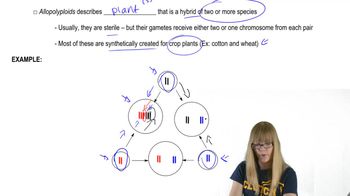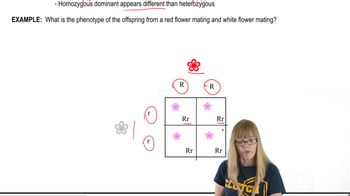Table of contents
- 1. Introduction to Genetics51m
- 2. Mendel's Laws of Inheritance3h 37m
- 3. Extensions to Mendelian Inheritance2h 41m
- 4. Genetic Mapping and Linkage2h 28m
- 5. Genetics of Bacteria and Viruses1h 21m
- 6. Chromosomal Variation1h 48m
- 7. DNA and Chromosome Structure56m
- 8. DNA Replication1h 10m
- 9. Mitosis and Meiosis1h 34m
- 10. Transcription1h 0m
- 11. Translation58m
- 12. Gene Regulation in Prokaryotes1h 19m
- 13. Gene Regulation in Eukaryotes44m
- 14. Genetic Control of Development44m
- 15. Genomes and Genomics1h 50m
- 16. Transposable Elements47m
- 17. Mutation, Repair, and Recombination1h 6m
- 18. Molecular Genetic Tools19m
- 19. Cancer Genetics29m
- 20. Quantitative Genetics1h 26m
- 21. Population Genetics50m
- 22. Evolutionary Genetics29m
19. Cancer Genetics
Overview of Cancer
Problem 7
Textbook Question
As a genetic counselor, you are asked to assess the risk for a couple with a family history of familial adenomatous polyposis (FAP) who are thinking about having children. Neither the husband nor the wife has colorectal cancer, but the husband has a sister with FAP. What is the probability that this couple will have a child with FAP? Are there any tests that you could recommend to help in this assessment?
 Verified step by step guidance
Verified step by step guidance1
<insert step 1: Understand the genetic basis of familial adenomatous polyposis (FAP). FAP is an autosomal dominant disorder caused by mutations in the APC gene. This means that only one copy of the mutated gene is needed for an individual to be affected.>
<insert step 2: Analyze the family history. The husband's sister has FAP, indicating that one of the husband's parents likely carries the mutated APC gene. Since the husband does not have FAP, he likely did not inherit the mutated gene.>
<insert step 3: Determine the husband's genotype. Since FAP is autosomal dominant and the husband does not have the condition, he is likely homozygous for the normal APC gene (i.e., he does not carry the mutation).>
<insert step 4: Assess the risk for the couple's children. If the husband does not carry the mutated gene, he cannot pass it on to his children. Therefore, the risk of their children having FAP is negligible.>
<insert step 5: Recommend genetic testing. To confirm the husband's genotype, genetic testing for the APC mutation can be performed. This will provide a definitive answer regarding his carrier status and further inform the risk assessment for their children.>
Recommended similar problem, with video answer:
 Verified Solution
Verified SolutionThis video solution was recommended by our tutors as helpful for the problem above
Video duration:
2mPlay a video:
Was this helpful?
Key Concepts
Here are the essential concepts you must grasp in order to answer the question correctly.
Familial Adenomatous Polyposis (FAP)
Familial Adenomatous Polyposis (FAP) is a hereditary condition characterized by the development of numerous polyps in the colon and rectum, which significantly increases the risk of colorectal cancer. It is caused by mutations in the APC gene, and individuals with FAP typically have a 100% risk of developing colorectal cancer if untreated. Understanding FAP is crucial for assessing genetic risks in families with a history of the condition.
Recommended video:
Guided course

Allopolyploidy
Autosomal Dominant Inheritance
FAP follows an autosomal dominant inheritance pattern, meaning that only one copy of the mutated gene from an affected parent can lead to the condition in offspring. In this case, the husband’s sister has FAP, indicating that the husband may carry the mutation. This concept is essential for calculating the probability of the couple's children inheriting the condition, as each child has a 50% chance of inheriting the mutated gene if the father is a carrier.
Recommended video:
Guided course

Variations on Dominance
Genetic Testing and Counseling
Genetic testing can identify mutations in the APC gene, providing critical information for assessing the risk of FAP in the couple's children. Genetic counseling can help the couple understand their options, including testing for the husband to determine if he carries the mutation. This process aids in informed decision-making regarding family planning and potential surveillance strategies for early detection of colorectal cancer.
Recommended video:
Guided course

History of Genetics

 9:51m
9:51mWatch next
Master Cancer Characteristics with a bite sized video explanation from Kylia Goodner
Start learningRelated Videos
Related Practice



